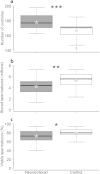Neonicotinoid pesticides severely affect honey bee queens
- PMID: 26459072
- PMCID: PMC4602226
- DOI: 10.1038/srep14621
Neonicotinoid pesticides severely affect honey bee queens
Abstract
Queen health is crucial to colony survival of social bees. Recently, queen failure has been proposed to be a major driver of managed honey bee colony losses, yet few data exist concerning effects of environmental stressors on queens. Here we demonstrate for the first time that exposure to field-realistic concentrations of neonicotinoid pesticides during development can severely affect queens of western honey bees (Apis mellifera). In pesticide-exposed queens, reproductive anatomy (ovaries) and physiology (spermathecal-stored sperm quality and quantity), rather than flight behaviour, were compromised and likely corresponded to reduced queen success (alive and producing worker offspring). This study highlights the detriments of neonicotinoids to queens of environmentally and economically important social bees, and further strengthens the need for stringent risk assessments to safeguard biodiversity and ecosystem services that are vulnerable to these substances.
Figures






References
-
- National Research Council. Status of Pollinators in North America. The National Academies Press (2007).
-
- Potts S. G., Biesmeijer J. C., Kremen C., Neumann P., Schweiger O. & Kunin W. E. Global pollinator declines: trends, impacts and drivers. Trends Ecol. Evol. 25, 345–353 (2010). - PubMed
Publication types
MeSH terms
Substances
LinkOut - more resources
Full Text Sources
Other Literature Sources
Medical

